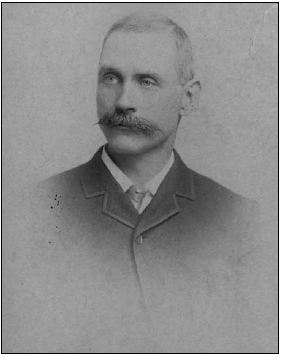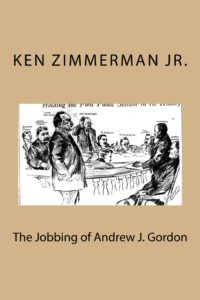Officer and Deputy Confront Violent Man
On August 31, 1901, Night Watchman William Doherty discovered Willis Garner burglarizing the office of Schickle, Harrison and Howard Iron Company at 912 S. Twelfth Street in St. Louis, Missouri. The iron company employed Garner, who threw a hammer at Doherty’s head. The hammer missed its target but the confusion allowed Garner to jump out the window and make his escape.

Detective James Tracey Who Brought H.M. Brooks Back to St. Louis
On September 2, 1901, Detective James Tracy, who brought the St. Louis Trunk Murderer Hugh Brooks back from Australia in 1885, attempted to arrest Garner. Garner went to the iron company to pick up his pay. Whether due to greed or a belief the watchman did not recognize him, Garner boldly walked into the iron company to pick up his pay.
Detective Tracy stepped into the office and placed his hand on his arm to indicate his arrest for burglary. Garner pulled out a knife and cut Tracy’s jacket and vest to shreds. Miraculously, Tracy escaped serious injury but was unable to prevent Garner’s escape.
Since Willis Garner was black, St. Louis Chief of Detectives William Desmond put one of his two African-American St. Louis Special Officers, Andrew J. Gordon, on the case. Special Officer Gordon made over 900 arrests in a five year period and was one of the most effective officers in St. Louis Police history.
Special Officer Gordon received his first break on March 12, 1902, when Julius Page, a black St. Louisan living at 1533 Singleton Street, reported to Gordon that Garner stole $37 worth of clothing from his room. Gordon now knew Garner was back in St. Louis.
Gordon knew that Garner’s mother-in-law, Mrs. Laura Choppel, kept a boarding house in the rear of 1932 St. Charles Street. Gordon and Deputy Sheriff Brownlow Sexton, the only black Deputy Sheriff in St. Louis, went to Mrs. Choppel’s house and inquired after Garner.
Mrs. Choppel told Gordon that she had not seen Garner for some time. Mrs. Choppel’s manner made Gordon suspicious. He and Sexton began a search of the house. They found Garner hiding under the bed in an upstairs room. Gordon pulled his revolver and ordered Garner out. Garner grabbed Gordon’s gun instead.
Gordon fired a shot but Garner ran out of the room dragging Gordon, who was trying to tackle him. Garner turned to attack Gordon, who was preventing his escape down the stairs.
Gordon shot Garner one time. Garner began to flee down the steps but Gordon shot him four more times. Garner died in the back yard. Today, Gordon would not be able to shoot a fleeing felon but policing was not as professional at the turn of the century.
A St. Louis Grand Jury did charge Gordon with second degree murder, when Brownlow Sexton changed his story several months after a coroner’s jury found Gordon killed Garner in self-defense. At the trial, Gordon was acquitted.
Brownlow Sexton was charged with perjury for changing his story. Fearing conviction, Sexton fled to Chicago but was captured by Chicago Police on information from Chief Desmond. Sexton was convicted and sentenced to two years in the Missouri Penitentiary.
Officer Gordon made a splendid record in his five year career which would open doors to other black officers in the future.
You can leave a comment or ask a question about this or any post on my Facebook page.
You can purchase a copy of Andrew J. Gordon and The Integration of St. Louis Police on Amazon.
Pin It

